Grimsby
Explore hidden histories, historic photos, and things you never knew about Grimsby from the collections and archives of Historic England.
Discover your local listed buildings and places
Introducing some of Grimsby's most historic sites, included in the National Heritage List for England. Some of these captions have been summarised by AI. Click through for the official List entry. Skip this section and go to place by numbers
The Dock Tower
Grimsby
The Dock Tower in Grimsby, built in 1851-2, is the largest hydraulic tower in the UK, representing an early stage of hydraulic-power technology.
Church of St Nicolas
Great Coates
Summary of Importance: Not provided. Reasons for Designation: Not provided.
Alfred Enderby Ltd Fish Smoking and Processing Factory
Grimsby
An inter-war fish curers with smokehouses, converted from a late-C19/early-C20 building.
Castle Press
Grimsby
Artillery barracks and headquarters, constructed in 1891 for the 1st Lincolnshire Volunteer Position Artillery, and later converted to a printing works.
Great Coates First World War Memorial
Great Coates
First World War memorial, erected in 1920 on the former village Reading Room, Station Road, re-sited on the Village Nursery School in 2017.
Explore more
Search for more listed placesGrimsby through time
This timeline shows the first period of use for buildings and places on the National Heritage List for England, just one of the details recorded for every list entry. Click around to see how Grimsby changes over time. Skip this section and go to aerial photos
Early medieval AD 410 to AD 1066
This period, often associated in England with Anglo-Saxons and Vikings, saw a reduction in urban living from the Roman period and increased migration from northern Europe.
Traces of this period can be found in cemeteries, particularly in artefacts and in some of the very early churches, as this period also saw the growth of Christianity in Britain.
Medieval AD 1066 to AD 1540
This period, sometimes known as the Middle Ages, began with the Norman invasion in AD 1066. It saw a significant rise in military and defensive buildings such as castles and earthworks, as well as religious houses dominating a largely agricultural landscape.
The monarchy and Church dominated the period, which also saw the break with the Roman Catholic Church and the English reformation.
Post medieval AD 1540 to AD 1901
The Post-Medieval period brought seismic changes to life in England, with religious reformation leading to the democratization of worship and the destruction of hundreds of religious houses.
In parallel, there was a huge expansion of scientific study and enlightenment that permanently altered the nation's social structure and landscape. Industrialization and mass production lead to wider global trade, emigration, and immigration.
20th century AD 1901 to AD 2000
The 20th century saw an incredible expansion of England's transport networks, with suburban growth shadowing rapid infrastructural expansion. The establishment of state schools, hospitals, and modern technical colleges, with new architectural styles, radically changed the appearance of towns and cities.
Two catastrophic world wars and the 1918 pandemic also brought unprecedented change, altering England's built environment and social structures forever.
Early medieval AD 410 to AD 1066
This period, often associated in England with Anglo-Saxons and Vikings, saw a reduction in urban living from the Roman period and increased migration from northern Europe.
Traces of this period can be found in cemeteries, particularly in artefacts and in some of the very early churches, as this period also saw the growth of Christianity in Britain.
Medieval AD 1066 to AD 1540
This period, sometimes known as the Middle Ages, began with the Norman invasion in AD 1066. It saw a significant rise in military and defensive buildings such as castles and earthworks, as well as religious houses dominating a largely agricultural landscape.
The monarchy and Church dominated the period, which also saw the break with the Roman Catholic Church and the English reformation.
Post medieval AD 1540 to AD 1901
The Post-Medieval period brought seismic changes to life in England, with religious reformation leading to the democratization of worship and the destruction of hundreds of religious houses.
In parallel, there was a huge expansion of scientific study and enlightenment that permanently altered the nation's social structure and landscape. Industrialization and mass production lead to wider global trade, emigration, and immigration.
20th century AD 1901 to AD 2000
The 20th century saw an incredible expansion of England's transport networks, with suburban growth shadowing rapid infrastructural expansion. The establishment of state schools, hospitals, and modern technical colleges, with new architectural styles, radically changed the appearance of towns and cities.
Two catastrophic world wars and the 1918 pandemic also brought unprecedented change, altering England's built environment and social structures forever.
Aerial photos of Grimsby
Aerial photography helps reveal secrets of England's changing landscapes that are impossible to see from the ground. Skip this section and go to archive images
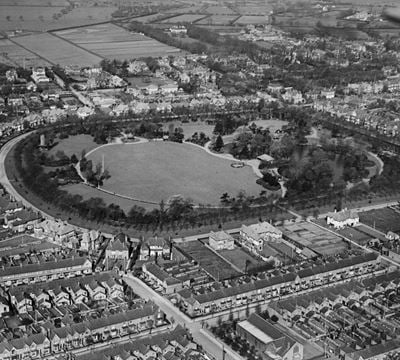
Grimsby
People's Park and environs, Grimsby, 1925
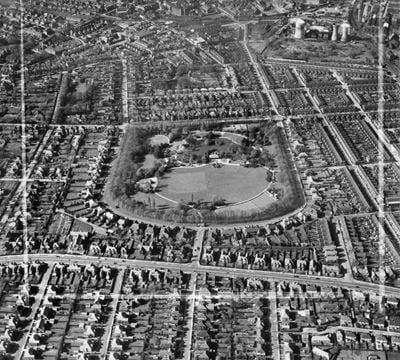
Wellow
People's Park, Wellow, 1950
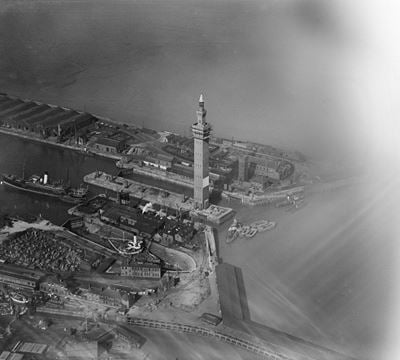
Grimsby
The Dock Tower, Grimsby, 1925

Grimsby
The Royal Dock and Tidal Basin, Grimsby, 1950
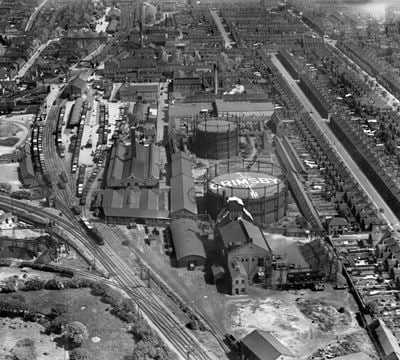
Grimsby
Grimsby Gas Works, Sheepfold Street and environs, Grimsby, 1933

Grimsby
The Osmond and Sons Ltd Moss Road Works alongside the Moss Road Power Station, Grimsby, 1953
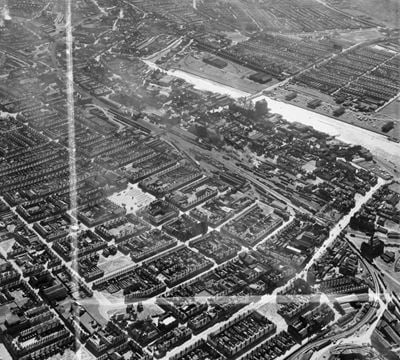
Grimsby
The town around Freeman Street Market and Grimsby Docks Railway Station, Grimsby, 1950

Grimsby
The Osmond and Sons Ltd Railway Street Works, Grimsby, 1953
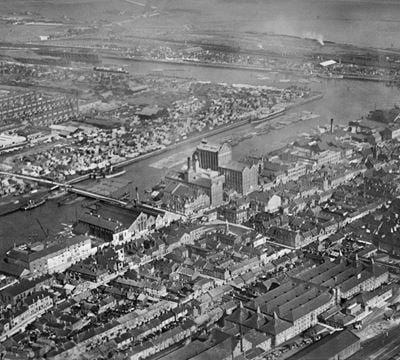
Grimsby
Alexandra Dock, Central Market and environs, Grimsby, 1925

Grimsby
Victoria Flour Mills, Corporation Bridge and environs, Grimsby, 1937
Grimsby in the Historic England Archive
The Historic England Archive cares for over 15 million images, dating from the 1850s to the present day. Discover stunning images of Grimsby's past. Skip this section and go to stories about heritage
John Gay Collection: Counties
Great Grimsby, Grimsby, North East Lincolnshire
Date created: 1950s
Looking up at the south transept and central tower of St James' Church, seen at night through the branches of a winter tree
John Laing Collection
Grimsby, North East Lincolnshire
Date created: 26 May 1948
Blocks of terraced Easiform housing on a housing estate in Grimsby
Alfred Newton and Sons
Grimsby, North East Lincolnshire
Date created: Jul 1898
GENERAL VIEW SHOWING BOATS INCLUDING THE AQUARIUS
Nigel Temple Collection of Postcards of Parks and Gardens
Grimsby, North East Lincolnshire
Date created: 1901 - 1906
GENERAL VIEW LOOKING TOWARDS THE LODGE AND GATES
John Gay Collection: Counties
Great Grimsby, Grimsby, North East Lincolnshire
Date created: 1950s
Looking up at the south transept and central tower of St James' Church, seen at night through the branches of a winter tree
John Laing Collection
Grimsby, North East Lincolnshire
Date created: 26 May 1948
A view looking down a street of Easiform housing in Grimsby
Alfred Newton and Sons
Royal Dock, Grimsby, North East Lincolnshire
Date created: Jul 1898
GENERAL VIEW
Nigel Temple Collection of Postcards of Parks and Gardens
Grimsby, North East Lincolnshire
Date created: 1900 - 1904
GENERAL VIEW OF THE LODGE AND GATES FROM A FLOWER BED IN THE FORM OF A CROWN
John Gay Collection: Counties
Great Grimsby, Grimsby, North East Lincolnshire
Date created: 1950s
Looking up at the north transept and central tower of St James' Church, seen at night through the branches of a winter tree
John Laing Collection
Grimsby, North East Lincolnshire
Date created: 26 May 1948
A block of terraced Easiform houses at 1-4 Blaydon Grove, Grimsby
Alfred Newton and Sons
Grimsby, North East Lincolnshire
Date created: Jul 1898
GENERAL VIEW SHOWING SHIPS IN DOCK
Nigel Temple Collection of Postcards of Parks and Gardens
Grimsby, North East Lincolnshire
Date created: 1900 - 1920
GENERAL VIEW BESIDE THE BANDSTAND
Stories about heritage in your local area
Historic England publishes news, blogs, research, videos, and podcasts celebrating England's rich heritage. Discover the stories we have about Grimsby. Skip this section and go to education
Historic Character and Good Design
Mentions Grimsby
Article exploring how historic character is a positive force in building distinctive, better designed, places.
16 Remarkable Historic Places Listed in 2023
Mentions Grimsby
Take a closer look at the historic gems that were examined, protected and added to the National Heritage List for England in 2023.
Heritage and Craft Workers Across England Given a Helping Hand
Mentions Grimsby
142 historic sites across England are receiving grants worth £35 million through the government’s Culture Recovery Fund.
Heritage at Risk 2018
Mentions Grimsby
Historic England unveils latest chapter in the fight to save important heritage in 20th year of the national Register.
Heritage Minister Announces Historic Places to Be Revived – and They're Concentrated in the North and Midlands
Mentions Grimsby
John Glen, Minister for Arts, Heritage and Tourism, today announced the latest historic places to be revived through the Heritage Action Zone scheme.
Grimsby's social history through photos
Over 10,000 images from the Historic England Archive have been specially selected and re-captioned for teachers, students, and anyone who wants to learn more about their local area. Skip this section and go to grant-aided places
Town Hall, Town Hall Square, Grimsby, North East Lincolnshire
Period: Victorian (1837 - 1901)
The town hall was built in 1861-3 by Bellamy and Hardy of Lincoln and John Giles of London. It is built in yellow brick and has a slate roof.
Town Hall, Town Hall Square, Grimsby, North East Lincolnshire
The Docks, Grimsby, North Lincolnshire
Period: Victorian (1837 - 1901)
These ships were pictured in 1898 moored at Grimsby Docks. Fishing is a major industry in the town, leading to the importance of the docks.
The Docks, Grimsby, North Lincolnshire
Sir Moses Montefiore Synagogue, Heneage Road, Grimsby, North East Lincolnshire
Period: Victorian (1837 - 1901)
This synagogue was built in 1885-8. The foundation stone was laid by F D Mocatta of London, July 22nd 1885.
Sir Moses Montefiore Synagogue, Heneage Road, Grimsby, North East Lincolnshire
MTL Medal Fisheries, Surtees Street, Grimsby, North East Lincolnshire
Period: Victorian (1837 - 1901)
This fish processing and smoking factory was built in the late 19th century.
MTL Medal Fisheries, Surtees Street, Grimsby, North East Lincolnshire
Haven Mill, Garth Lane, Grimsby, North East Lincolnshire
Period: Victorian (1837 - 1901)
This building was originally a flour mill, maltings and warehouse. It was built in the early 1800s. The area was known as West Haven.
Haven Mill, Garth Lane, Grimsby, North East Lincolnshire
Grimsby, North East Lincolnshire
Period: 1950s (1950 - 1959)
Goods being unloaded from a large vessel moored by the quay side.
Grimsby Haven Lock, Lock Hill, Grimsby, North East Lincolnshire
Period: Georgian (1714 - 1836)
The Grimsby Haven Lock and dock wall was built in 1798-9 by John Rennie, engineer, for the Grimsby Haven Company.
Grimsby Haven Lock, Lock Hill, Grimsby, North East Lincolnshire
Grimsby Cordage Mill, Ropery Street, Grimsby, North East Lincolnshire
Period: Victorian (1837 - 1901)
This Cordage mill was built for the manufacture of twine and nets in 1899. It was built for the Grimsby Cordage Co.
Grimsby Cordage Mill, Ropery Street, Grimsby, North East Lincolnshire
Discover more
Ready for more local stories? Take a look at these other places nearby

North East Lincolnshire
Local Authority District

Lincolnshire
Ceremonial County

Kingston upon Hull, City of
Local Authority District